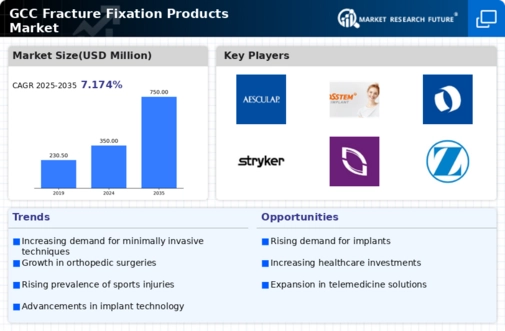Rising Healthcare Expenditure
In recent years, there has been a marked increase in healthcare expenditure across the GCC, which is positively influencing the fracture fixation-products market. Governments in the region are investing heavily in healthcare infrastructure and services, aiming to improve patient outcomes and access to advanced medical technologies. For instance, healthcare spending in the GCC is projected to reach $100 billion by 2025, with a significant portion allocated to orthopedic care. This surge in investment is likely to enhance the availability of state-of-the-art fracture fixation products, thereby fostering market expansion and improving treatment options for patients.
Aging Population and Increased Bone Fragility
The demographic shift towards an aging population in the GCC is significantly impacting the fracture fixation-products market. As individuals age, the risk of osteoporosis and related fractures increases, leading to a higher demand for effective fixation solutions. It is estimated that by 2030, the elderly population in the GCC will constitute over 15% of the total population, which could result in a substantial rise in orthopedic procedures. This demographic trend necessitates the development of advanced fracture fixation products that cater to the specific needs of older patients, thereby driving market growth and innovation.
Growing Awareness of Advanced Treatment Options
The fracture fixation-products market is benefiting from a heightened awareness among both healthcare providers and patients regarding advanced treatment options. Educational initiatives and marketing campaigns are increasingly informing stakeholders about the benefits of modern fixation devices, including their effectiveness and safety. This awareness is crucial in the GCC, where traditional methods are often preferred. As more healthcare professionals advocate for the use of innovative fixation products, the market is expected to witness a shift towards these advanced solutions, potentially increasing their market share by 10% over the next few years.
Technological Innovations in Product Development
Technological advancements are playing a pivotal role in shaping the fracture fixation-products market. Innovations such as bioresorbable implants, smart fixation devices, and 3D-printed orthopedic solutions are emerging, offering enhanced performance and patient outcomes. The GCC region is witnessing a surge in research and development activities aimed at creating cutting-edge products that address specific clinical needs. As these technologies become more accessible, they are likely to transform the landscape of fracture management, leading to increased adoption rates and a projected market growth of 12% annually in the coming years.
Increasing Demand for Minimally Invasive Procedures
The fracture fixation-products market is experiencing a notable shift towards minimally invasive surgical techniques. This trend is driven by the growing preference among healthcare professionals and patients for procedures that reduce recovery time and minimize scarring. In the GCC region, the adoption of these techniques is expected to rise, as they are associated with lower complication rates and shorter hospital stays. The market for minimally invasive fracture fixation products is projected to grow at a CAGR of approximately 8% over the next five years. This increasing demand is likely to propel innovation in product design and functionality, thereby enhancing the overall efficacy of fracture management.

















Leave a Comment